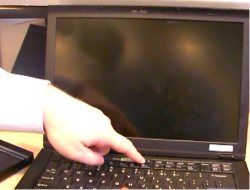Phoenix's 1-Second Instant Boot Bios Really Works

Big foot. The Loch Ness Monster. The Chupacabra. Instant-on notebooks. We've heard a lot about them, but never seen one in the wild. While we have seen light, fast-booting Linuxes like Phoenix Hyperspace and Splashtop, none of them is exactly instant. Even with the boot-speed improvements in Windows 7, we always find ourselves waiting a good 45 to 50 seconds on even the fastest SSD-based notebooks we've tested.
One big reason why no operating system can really boot instantly is that the BIOS itself take anywhere from 5 to 10 seconds of turning on devices (the hard drive, CPU, ports, controllers, etc) before it even lets the operating system start loading off of the hard drive or SSD. So even if Windows could load immediately, you would still have to wait quite a while for it.
Enter Phoenix's new Instant Boot BIOS. It cuts down the post time to roughly one second. Phoenix's Chief Scientist Steve Jones explained that the new BIOS uses UEFI technology (a new kind of BIOS platform) to power on several system devices simultaneously and to run only those processes which are absolutely necessary to hand control over to the OS.
We had a chance to view Instant Boot in action on a Lenovo T400s, which was equipped with a high-speed SSD. About one second after hitting the power button, we saw the hard drive light flickering and noticed that Windows had already started loading. Because this system had a high-speed SSD and the Windows install didn't have a lot of exra drivers or crapware, Windows 7 itself took only 10 seconds to get us to a desktop.
We have video of the boot up process below so you can see what we saw. Just don't blame us if you drool on your keyboard.
[flq:ea928931bf0e4695993ad165dc17cc7e]
Jones showed us a report from Microsoft Velocity, a performance logging tool, that indicated the BIOS took 1.37 seconds to hand over control to the OS. He told us that further optimizations for individual notebooks could even lower that time.
Stay in the know with Laptop Mag
Get our in-depth reviews, helpful tips, great deals, and the biggest news stories delivered to your inbox.
Clearly, there are some caveats. The Instant Boot BIOS only helps you get to the OS; it's not going to make a slow-loading OS become fast. And the Windows 7 install we saw was not running Aero so who knows if that might add a little to the boot process.
However, we can't help but be incredibly impressed. Phoenix has removed the BIOS bottleneck from the boot process and really put the ball into the OEM's court. A system will load as fast as its operating system, and runtime software will let it. And even if 11 seconds is not quite Big Foot, it's an extremely hairy animal!
Jones told us that it is offering Instant Boot functionality to its OEM partners, who will be able to use it in new notebooks or even, quite possibly, offer it as a BIOS upgrade to some existing systems. He could not tell us what vendors, if any, have already signed on to use this technology in their systems.
We're left to wonder whether OEMs who adopt this Instant Boot technology will charge a premium for it. If so, would you pay extra for faster boot times? Or would you choose a notebook that had this feature over one that did not?
